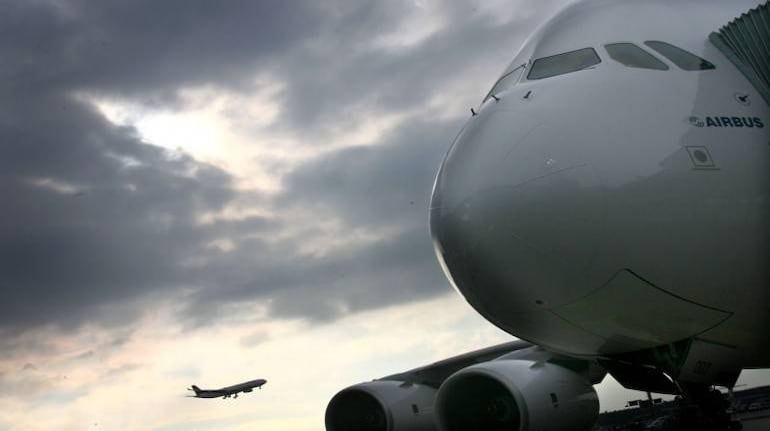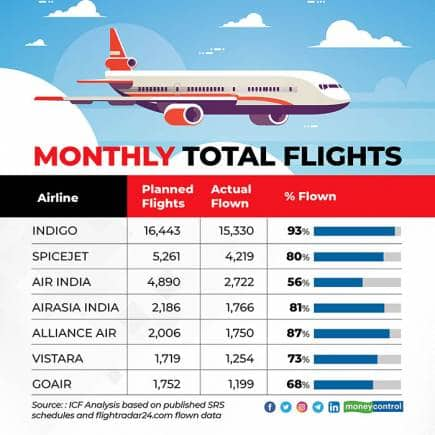



We are nearly four months into the restart of domestic aviation services. While the allowed capacity has increased from 33 percent to 60 percent and most rules — either around quarantine requirements or city pairs — are being relaxed, traffic hasn’t returned anywhere near what it was pre-Covid.
But for passengers reeling from having their money tied up in shells with airlines, to be used within a year, there has been no respite from flight cancellations.
Data released by DGCA shows that the flight cancellation rate in August was 4 percent, while it was over 6 percent in July.
In January, before the Covid-19 crisis hit, the cancellation rate stood at 1.7 percent, when there were three times as many flights in Indian skies.
Reasons for cancellation
While the cancellation percentage only looks at half the story, the regulator also declares the reasons for cancellations. While traditionally they have been stacked towards weather, technical or reactionary reasons, the last few months have seen a high percentage of cancellations being attributed to Commercial reasons.
In August, 44.6 percent of all cancellations were attributed to commercial reasons, while it was nearly 50 percent in July. Interestingly, in January, the cancellations attributed to commercial reasons were only 2.5 percent, with the major reason for cancellation being weather, followed by technical.
What exactly is a commercial cancellation? More often than not it is a direct indication that the flight was cancelled due to lack of passengers on either the onward or return leg or both. While traditionally, airlines had very few commercial cancellations, the numbers have risen steadily, to around 50 percent of all cancellations.
Global consulting and digital services company ICF came up with an exclusive analysis on the flights scheduled and operated by each of the airlines in India. This analysis was based on published schedules in SRS Analyzer (an airline data analytics tool) and actual flights as reported by real-time flight tracker flightradar24.com.
How do major airlines stack up?
Amongst the major airlines in the country, market leader IndiGo flew 93 percent of its scheduled flights and was the topper, while Air India flew only 56 percent of the flights it intended to fly.
AirAsia India and Spicejet operated 81 percent and 80 percent of their planned flights in August.

Interestingly, Alliance Air, the wholly owned subsidiary and regional arm of national carrier Air India, had planned more flights than Vistara or Go Air and ended up operating 87 percent of those. Alliance Air is focussed on routes under the Regional Connectivity Scheme (RCS)-UDAN. Flights under RCS-UDAN have their own pricing structure and are currently out of the purview of the upper and lower fare bands, which will be in place until this November.
Predictability
Traditionally, the Mumbai-Delhi corridor has been the most sought after route in terms of traffic, and data shows that airlines were bullish about the route, with over 600 flights planned each way. However, only 65 percent were eventually operated, on average, by the domestic carriers.
By contrast, the second-most popular sector, Delhi-Hyderabad, saw most of the flights operated as planned, with a flown-to-scheduled ratio of 99 percent.
The top five sectors were Delhi-Mumbai-Delhi, Delhi-Hyderabad-Delhi, Delhi-Bengaluru-Delhi, Delhi-Patna-Delhi and Delhi-Srinagar-Delhi. Since the Covid-19 outbreak, Delhi has established itself as the centre of the aviation scene in India for both domestic and international services.
Where is the traffic?
The traffic flows captured by aviation consultancy ICF show that there were far more flights from Tier II cities such as Patna, Srinagar and Guwahati to Tier I cities. The number of such flights was over 2.5 times of those among Tier I cities.
“This phenomenon is due to workers returning to big cities to resume their jobs, a trend opposite to that observed in June, when most workers left for their hometowns,” said Piyush Bansal, Operations Lead at ICF Aviation in India. “The Delhi-Patna route, for example, has been among the top three domestic routes since June. Pre-lockdown, this route did not feature in the top ten.”
The traffic uptick has been unpredictable at best. Coupled with varying rules around quarantine, weekend lockdowns and more at different places across the country, aviation is not what it used to be. The ever-changing landscape has made planning difficult for airlines. Years of data and historical numbers are of little use as airlines have to be on their toes to adjust to the quick changing nature of the business and traffic.
But the larger percentage of cancellations shows that things are not going as planned and airlines are being more optimistic than they should be. With a cap on both capacity and fares, IndiGo seems to be making the most of the situation due to its larger network and ability to feed traffic across multiple points in the country.
Discover the latest Business News, Sensex, and Nifty updates. Obtain Personal Finance insights, tax queries, and expert opinions on Moneycontrol or download the Moneycontrol App to stay updated!
Find the best of Al News in one place, specially curated for you every weekend.
Stay on top of the latest tech trends and biggest startup news.